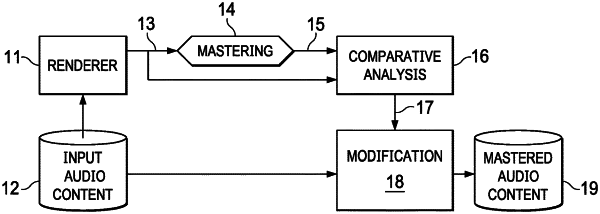| CPC H04S 3/008 (2013.01) [H04R 5/04 (2013.01); H04S 7/301 (2013.01); H04S 2400/01 (2013.01); H04S 2420/03 (2013.01)] | 20 Claims |

|
1. A method for generating mastered audio content, the method comprising:
providing an input audio content comprising a number, M1, of audio signals;
providing rendered presentation of said input audio content, said rendered presentation comprising a number, M2, of audio signals;
providing a mastered presentation generated by mastering said rendered presentation;
comparing the mastered presentation with the rendered presentation to determine, for each time-frequency tile, a difference in an attribute between the mastered presentation and the rendered presentation; and
modifying the audio signals of the input audio content by superimposing the difference in the attribute on each corresponding time-frequency tile of each audio signal to generate the mastered audio content.
|
|
16. A computer implemented system for generating mastered audio content, the system comprising:
an analysis module configured to:
receive a rendered presentation comprising a number, M2, of audio signals and a mastered presentation generated by mastering said rendered presentation, and
compare the mastered presentation with the rendered presentation to determine, for each time-frequency tile, a difference in an attribute between the mastered presentation and the rendered presentation; and
a modification module configured to:
receive said indications of differences and an input audio content comprising a number, M1, of audio signals, and
modify one or more of the audio signals of the input audio content by superimposing the difference in the attribute on each corresponding time-frequency tile of the input audio content to generate the mastered audio content.
|